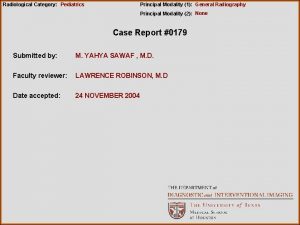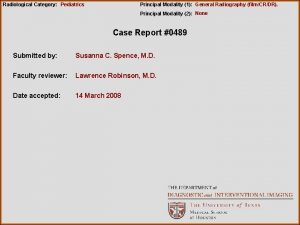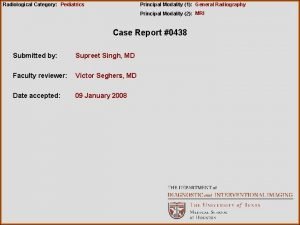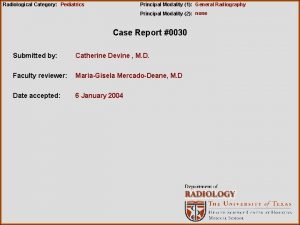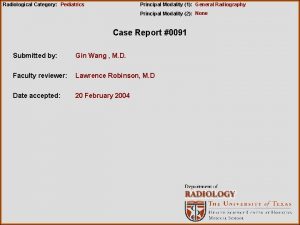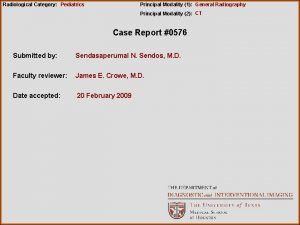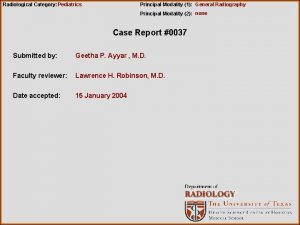Radiological Category Pediatrics Principal Modality 1 General Radiography








- Slides: 8

Radiological Category: Pediatrics Principal Modality (1): General Radiography Principal Modality (2): none Case Report #0038 Submitted by: Geetha P. Ayyar, M. D. Faculty reviewer: Susan John, M. D. Date accepted: 15 January 2004

Case History Child with history of chronic renal insufficiency.

Radiological Presentations

Test Your Diagnosis Which one of the following is your choice for the appropriate diagnosis? After your selection, go to next page. • juvenile rheumatoid arthritis • skeletal dysplasia • rickets • achondroplasia

Findings and Differentials Findings: There is metaphyseal cupping and fraying noted in the distal radius and ulna. Differentials: • rickets

Discussion Rickets refers to osteomalacia in children. It is the bony manifestation of a variety of problems secondary to a relative or absolute Vitamin D deficiency – – – dietary lack of vitamin D Lack of sunshine exposure Malabsorption of vitamin D (pancreatitis, biliary ds, steatorrhea, celiac ds, Inflamm bowel ds) Defective conversion of Vitamin D to 25 -OH –Cholecalciferol in LIVER – – Liver disease Drugs that activate P 450 hepatic enzymes and accelerate degradation of Vitamin D metabolites Defective Conversion of 25 -OH-D 3 (inactive) to 1, 25 -OH-D 3 (active) in KIDNEY – – Chronic renal failure – renal osteodystrophy Autosomal recessive enzyme defect of 1 -OHase Rickets can also be secondary to a variety of abnormalities in phosphate metabolism such as phosphate deficiency or disorders of renal tubular reabsorption of phosphate (Fanconi syndrome, Vitamin D-resistant rickets, Ifosfamide nephrotoxicity from treatment of Wilms tumor). The third class of causes is secondary to calcium deficiency including dietary rickets, malabsorption, and consumption of substances forming chelates with calcium. The lack of Vitamin D results in insufficient conversion of growing cartilage into mineralized osteoid and therefore build-up of nonossified osteoid. These changes are most prominent in the metaphyses of bones with rapid growth. These changes can be seen on frontal views of the knees and wrists.

Discussion Radiographic findings include: ü irregular widened epiphyseal plates due to increase unossified osteoid üIncrease in distance between end of shaft and epiphyseal center üCupping and fraying of metaphysis with threadlike shadows into epiphyseal cartilage üCoarse trabeculation (unsharp, smudged-appearing trabecular markings) üperiosteal reaction üBowing of long bones Other associated findings include craniotabes, rachitic rosary, bowed legs, delayed dentition, swelling of wrists and ankles Patients are predisposed to insufficiency fractures (Looser zones) and slipped capital femoral epiphyses (SCFE). Donnelly, L. Fundamentals of Pediatric Radiology, 2001 p 208 -209 Blickman, Pediatric Radiology – The Requisites, 1998

Diagnosis Rickets secondary to chronic renal insufficiency.









